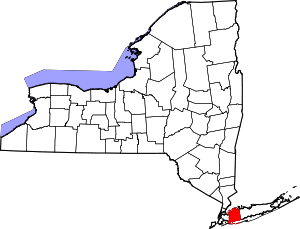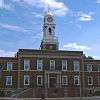Mineola, New York
| Mineola | |
|---|---|
| Village | |
| Incorporated Village of Mineola | |
|
Old Nassau County Courthouse | |
 Location in Nassau County and the state of New York. | |
 Mineola Location in Nassau County and the state of New York. | |
| Coordinates: 40°44′50″N 73°38′17″W / 40.74722°N 73.63806°WCoordinates: 40°44′50″N 73°38′17″W / 40.74722°N 73.63806°W | |
| Country |
|
| State |
|
| County | Nassau |
| Government | |
| • Mayor | Scott Strauss |
| Area | |
| • Total | 2.2 sq mi (4.8 km2) |
| • Land | 2.2 sq mi (4.8 km2) |
| • Water | 0.0 sq mi (0.0 km2) |
| Elevation | 108 ft (33 m) |
| Population (2010) | |
| • Total | 18,799 |
| Time zone | Eastern (EST) (UTC-5) |
| • Summer (DST) | EDT (UTC-4) |
| ZIP code | 11501 |
| Area code(s) | 516 |
| FIPS code | 36-47636 |
| GNIS feature ID | 0957391 |
| Website |
www |
Mineola is a village in Nassau County, Long Island, New York, USA. The population was 18,799 at the 2010 census. The name is derived from a Native American word meaning a "pleasant place".
Most of the Incorporated Village of Mineola is located in the Town of North Hempstead, with a small portion of its southern edge within the Town of Hempstead.[1] Old Country Road runs along the southern border of the village. The area serviced by the Mineola Post Office extends farther south into the adjacent village of Garden City, New York, where the county seat of Nassau County[2] is located. Offices of many Nassau County agencies are located in both Mineola and Garden City.
History
The central, flat, grassy part of Long Island was originally named "Hempstead Plains". In the 19th century various communities were started. One of them was called "Hempstead Branch", and finally, "Mineola".
Long Island was part of Henry Hudson's original claim in the name of the Dutch East India Company dating as far back as 1609. In the 18th century the Dutch and English settlers worked to clear farmland to start their life on the Hempstead Plains. It was in 1858 when this land was named after an Algonquin Indian Chief, Miniolagamika meaning, "Pleasant Village". The name was later shortened and altered to "Mineola".
From about 1787 until the 1870s, the area was the county seat for Queens County, in a section then known as Clowesville,[3][4][5][6][7][8][9][10][11][12][13][14] just outside the present village boundaries. The western portion of Queens became a borough of New York City in 1898, and in 1899 Nassau County was formed from the part of Queens that did not so consolidate. Voters selected Mineola (in the Town of North Hempstead) to be the county seat for the new county of Nassau in November 1898[15] (before Mineola incorporated as a village in 1906 and set its boundaries), winning out over Hicksville and Hempstead.[16] The Garden City Company (founded in 1893 by the heirs of Alexander Turney Stewart)[17] donated four acres of land for the county buildings just south of the Mineola train station and the present day Village of Mineola, in the Town of Hempstead.[18][19]
Mineola officially became the County Seat on July 13, 1900, as Governor Theodore Roosevelt laid the cornerstone of the Nassau County Court House. A celebration was held to commemorate the occasion on the barren 5-acre (20,000 m2) site at the corner of Old Country Road and Franklin Avenue. Many dignitaries were present to witness this event such as Frederick Hicks, Congressman Townsend Scudder, Colonel William Youngs and Supervisors William Jones and Edwin Willits.
Mineola was legally incorporated in 1906 and run by a president. The land on which the County buildings sat was not included as part of the village. The land and the buildings have a Mineola postal address, but are within the present day Village of Garden City,[20] which did not incorporate, nor set its boundaries, until 1919.
Winthrop-University Hospital, founded in 1896 by local physicians and residents as Nassau Hospital, was Long Island's first voluntary hospital. In 1897, it admitted 91 patients, performed 27 operations, and reported two births and eight deaths during the first year. The original hospital was constructed in 1900. Renamed Winthrop in the 1980s, it is now a nationally-recognized award-winning hospital and in 2004 was ranked among the Top 5 Percent of Acute-Care Hospitals in the Country.
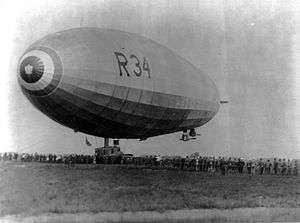
Mineola was also a familiar place to many of the most famous pilots in history. The Aero Club of America chose the area for the level plains. Glenn Curtiss brought the area to national attention in July 1909 with his second Scientific American Award flight of over 23 minutes and 15 miles. He also made some of the first public flights in America in his "Golden Flyer", while practicing for the Reims Aviation Meet in France. The Wright Brothers, Igor Sikorsky, Captain Rene Fonck, and the famed duo of Clarence Chamberlain and Bert Acosta, dubbed "twins of derring-do", all spent time in Mineola taking advantage of the rolling grasslands and favorable winds.
On November 1, 1915, Captain Raynal Cawthorne Bolling—a prominent New York attorney working at United States Steel—organized the Aviation Detachment, 1st Battalion Signal Corps of the New York National Guard (now the 102d Rescue Squadron). It was the Guard's first genuine aviation unit. Subsequently, the organization was redesignated the lst Aero Company. Located at Mineola on Long Island, the unit rented and then purchased its own aircraft with funds donated by the Aero Club of America and other contributors. It was "provisionally recognized" on June 22, 1916 and then called into federal service on July 13, 1916 during the Mexican border crisis. However, instead of active service in the southwest, it remained at Mineola training and was released from federal service on November 2, 1916.
On May 20, 1927, at 7:52 a.m., Charles Lindbergh started his historic flight from nearby Roosevelt Field. Thirty-three hours later he landed in Paris and became the first person to complete a solo flight from the United States across the Atlantic Ocean.
Main Street was the center of village business as well as a popular meeting place for farmers and the business community alike. The general store offered an array of goods that would fulfill most everyday needs, such as hardware, toys, wool, dry goods, clothing and food. The small glass-fronted mail and delivery boxes filled the existing six-foot post office. As the Mineola population grew, the post office was relocated to the Meyer Building on Mineola Boulevard and then twice more to 3rd Street and 2nd Street. It eventually found its permanent home on 1st Street and Main Street.
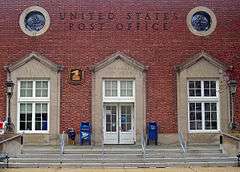
Mineola's first theatre named Allen's Hall drew in many early moviegoers to see "the flickers". Motion picture success drew in other theaters to the area, the most lavish being the Century Opera House. Most theaters had a showing in the morning and in the evening, usually featuring a live pianist who kept up with the action of the movie while playing music that suited the story.
As years passed, Jericho Turnpike became the commercial "main street", farmland was sold off, and homes and offices were built. Mineola has continued to be a community of growth and development.
Mineola held its centennial celebration in 2006.
Geography
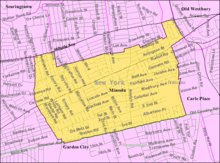
Mineola is located at 40°44′50″N 73°38′17″W / 40.747188°N 73.638088°W.[21]
According to the United States Census Bureau, the village has a total area of 1.9 square miles (4.9 km2), all of it land.
The villages bordering Mineola are Garden City, Old Westbury, East Williston, and Williston Park. Mineola also borders the hamlets (CDP) of Herricks, Garden City Park and Carle Place.
The village gained territory between the 1990 census and the 2000 census.[22]
Climate
| Climate data for Mineola, New York | |||||||||||||
|---|---|---|---|---|---|---|---|---|---|---|---|---|---|
| Month | Jan | Feb | Mar | Apr | May | Jun | Jul | Aug | Sep | Oct | Nov | Dec | Year |
| Record high °F (°C) | 71 (22) |
73 (23) |
85 (29) |
94 (34) |
97 (36) |
101 (38) |
108 (42) |
105 (41) |
97 (36) |
89 (32) |
83 (28) |
76 (24) |
108 (42) |
| Average high °F (°C) | 39.6 (4.2) |
43 (6) |
50 (10) |
61 (16) |
70 (21) |
80 (27) |
85 (29) |
83 (28) |
76 (24) |
65 (18) |
55 (13) |
45 (7) |
62.72 (16.93) |
| Average low °F (°C) | 26.3 (−3.2) |
28 (−2) |
34 (1) |
42 (6) |
51 (11) |
61 (16) |
66 (19) |
65 (18) |
58 (14) |
48 (9) |
40 (4) |
31 (−1) |
45.86 (7.65) |
| Record low °F (°C) | −4 (−20) |
−1 (−18) |
5 (−15) |
13 (−11) |
34 (1) |
43 (6) |
50 (10) |
46 (8) |
38 (3) |
27 (−3) |
18 (−8) |
−1 (−18) |
−4 (−20) |
| Average precipitation inches (mm) | 3.62 (91.9) |
3.17 (80.5) |
4.35 (110.5) |
4.15 (105.4) |
3.90 (99.1) |
3.85 (97.8) |
4.40 (111.8) |
3.72 (94.5) |
3.91 (99.3) |
4.08 (103.6) |
3.73 (94.7) |
3.82 (97) |
46.7 (1,186.1) |
| Source: The Weather Channel[23] | |||||||||||||
Demographics
| Historical population | |||
|---|---|---|---|
| Census | Pop. | %± | |
| 1880 | 313 | — | |
| 1910 | 1,981 | — | |
| 1920 | 3,016 | 52.2% | |
| 1930 | 8,155 | 170.4% | |
| 1940 | 10,064 | 23.4% | |
| 1950 | 14,831 | 47.4% | |
| 1960 | 20,519 | 38.4% | |
| 1970 | 21,845 | 6.5% | |
| 1980 | 20,757 | −5.0% | |
| 1990 | 18,994 | −8.5% | |
| 2000 | 19,234 | 1.3% | |
| 2010 | 18,799 | −2.3% | |
| Est. 2015 | 19,139 | [24] | 1.8% |
2010 census
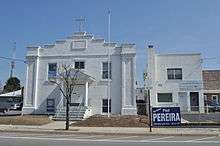
As of the census[26] of 2010, there were 18,799 people, 7,473 households, and 4,954 families residing in the village. The population density was 10,337.3 people per square mile (3,992.6/km²). There were 7,650 housing units at an average density of 4,111.5 per square mile (1,588.0/km²). The racial makeup of the village was 81.7% White, 71.5% Non-Hispanic White, 2.0% African American, 0.2% Native American, 8.5% Asian, 0.0% Pacific Islander, 5.3% from other races, and 2.3% from two or more races. 16.4% of the population is Hispanic or Latino of any race.
There were 7,473 households out of which 27.0% had children under the age of 18 living with them, 53.2% were married couples living together, 9.3% had a female householder with no husband present, and 33.7% were non-families. 29.1% of all households were made up of individuals and 11.8% had someone living alone who was 65 years of age or older. The average household size was 2.57 and the average family size was 3.20.
In the village the population was spread out with 20.2% under the age of 18, 7.4% from 18 to 24, 34.1% from 25 to 44, 22.6% from 45 to 64, and 15.7% who were 65 years of age or older. The median age was 38 years. For every 100 females there were 92.5 males. For every 100 females age 18 and over, there were 89.6 males.
The median income for a household in the village was $60,706, and the median income for a family was $71,042. Males had a median income of $47,182 versus $37,057 for females. The per capita income for the village was $28,890. About 2.6% of families and 4.2% of the population were below the poverty line, including 3.5% of those under age 18 and 5.4% of those age 65 or over.
2000 census
As of the census[26] of 2000, there were 19,234 people, 7,473 households, and 4,954 families residing in the village. The population density was 10,337.3 people per square mile (3,992.6/km²). There were 7,650 housing units at an average density of 4,111.5/sq mi (1,588.0/km²). The racial makeup of the village was 82.39% White, 1.03% African American, 0.29% Native American, 4.52% Asian, 0.04% Pacific Islander, 3.93% from other races, and 3.79% from two or more races. 13.03% of the population is Hispanic or Latino of any race.
There were 7,473 households out of which 27.0% had children under the age of 18 living with them, 53.2% were married couples living together, 9.3% had a female householder with no husband present, and 33.7% were non-families. 29.1% of all households were made up of individuals and 11.8% had someone living alone who was 65 years of age or older. The average household size was 2.57 and the average family size was 3.20.
In the village the population was spread out with 20.2% under the age of 18, 7.4% from 18 to 24, 34.1% from 25 to 44, 22.6% from 45 to 64, and 15.7% who were 65 years of age or older. The median age was 38 years. For every 100 females there were 92.5 males. For every 100 females age 18 and over, there were 89.6 males.
The median income for a household in the village was $60,706, and the median income for a family was $71,042. Males had a median income of $47,182 versus $37,057 for females. The per capita income for the village was $28,890. About 2.6% of families and 4.2% of the population were below the poverty line, including 3.5% of those under age 18 and 5.4% of those age 65 or over.
Government

The legislative body of the village, the board of trustees, is composed of the mayor and four trustees. Each member is elected to a two-year term. The board is charged with management of village property and finances, and may take all measures under the law for the good government of the village. The trustees may adopt a wide range of local laws to address village concerns.
They are appointed to be liaison officers to various community organizations throughout the village and report back to the board with updates at board meetings.[27]
The current trustees are:
- Mayor Scott Strauss
- Deputy Mayor Paul Pereira
- Trustee George Durham
- Trustee Paul Cusato
- Trustee Dennis Walsh
Police force
In 2005-2006, as a result of numerous recommendations from the community that Mineola increase its police force, a Mineola Police Task Force was appointed by Mayor Jack M. Martins to evaluate the feasibility of withdrawing from the Nassau County Police Department and establishing a village police force. The Mayor indicated to the Task Force at its inception that if the feasibility study resulted in a positive report, Mineola would only have its own police department if the residents approved such through a Village-wide referendum.[28]
The village board was split 3-2 in favor of the police force with Mayor Jack Martins, Deputy Mayor Werther and Trustee Davanzo supporting it while Trustees Fargrieve and Cusato opposed it. On December 5, 2006 the measure was defeated by a 2-1 margin.[29]
Education
Mineola is mostly served by the Mineola Union Free School District, which encompasses the communities of Mineola, Garden City Park, Williston Park, Albertson, and Roslyn Heights.[1] Smaller sections of Mineola are in the East Williston, Carle Place and Garden City School Districts.
In 2005, Assistant Superintendent John Jackson was arrested for stealing money and labor from the district totaling over $90,000. He pleaded guilty and in January 2006 was sentenced to 5 years probation and 90 days in jail. Reggie Carter, former basketball player for the New York Knicks, was Assistant Principal of Mineola High School (New York) until his death in 1999.
Mineola Union Free School District
- Mineola High School (located in Garden City Park)(grades 8-12)
- Mineola Middle School (grades 5 to 7)
- Jackson Avenue School (grades 3 & 4)
- Hampton Street School (grades Pre-K -2)
- Meadow Drive School (located in Albertson)(grades Pre-K -2)
Mineola Union Free School District is ranked 47th in NY state and 92nd nationally and has a rating of 8 out of 10.
Private schools
Mineola is also the location of Chaminade High School, a Catholic school with a history as an academically rigorous and highly disciplined school that has produced such graduates as Al D'Amato, U.S. Senator.[30]
Transportation
Mineola is the site of the Mineola Intermodal Center, which contains a Long Island Rail Road station, as well as a bus station. It is served by the following routes.
- n22: Jamaica - Hicksville via Hillside Avenue & Prospect Avenue
- n22X: Jamaica - Hicksville via Hillside Avenue & Prospect Avenue
- n23: Mineola - Manorhaven
- n24: Jamaica - Hicksville via Jericho Turnpike & Old Country Road
- n40: Mineola - Freeport via North Main Street
- n41: Mineola - Freeport via Babylon Turnpike
The n22A & n27 serve Mineola, but not the Intermodal Center.
Notable people

- Lenny Bruce (1925-1966), comedian.[31]
- Kenneth Chenault (born 1951), CEO of American Express.[32]
- Emmy Clarke (born 1991), actress who played the recurring character Julie Teeger on the USA Network show Monk.
- Brian Dennehy (born 1938), actor.[33]
- Jack Emmer, all-time winningest Division I men's college lacrosse coach for Army.[34]
- Louis V. Gerstner, Jr., the former Chairman of IBM and former Chairman of the Carlyle Group, was born and raised in Mineola. He attended Corpus Christi Grammar School and Chaminade High School, both in Mineola.
- Kevin James (born 1965), star of The King of Queens.[35]
- Elliot G. Jaspin (born 1946), 1979 winner of the Pulitzer Prize for Investigative Reporting.[36]
- James Patrick Kelly (born 1951), Hugo Award-winning author.[37]
- B. J. LaMura (born 1981), professional baseball pitcher who played for Italy in the 2009 World Baseball Classic.
- Jackie Martling (born 1948), former Howard Stern Show writer.[38]
- Carlos Mendes (born 1980), defender for Major League Soccer side New York Red Bulls.
- Bill Owens, Former Congressman for New York's 23rd District, was raised in Mineola, and is a graduate of Chaminade High School.
- Kim Richards (born 1964), child actress who starred in Nanny and the Professor, Escape to Witch Mountain, No Deposit, No Return, Return from Witch Mountain, as an adult, she made a cameo role as a waitress in Race to Witch Mountain.[39]
- Lauren Scala (born 1982), WNBC and New York Nonstop correspondent.
- Stephen Schwartz (born 1948), Grammy, Golden Globe and Academy Award winning writer and composer of Godspell, Wicked, Pippin, and The Magic Show and collaborator on the scores for Pocahontas and The Hunchback of Notre Dame graduated from Mineola High School in 1964.
- Robert B. Silvers (born 1929), editor of The New York Review of Books.[40]
- Frances Townsend (born 1961), US Homeland Security Adviser under President George W. Bush.[41]
- John Valentin (born 1967), former MLB player.[42]
- Chris Weidman (born 1984), UFC Middleweight Champion.
Miscellany
- Mineola has a central railroad station and Nassau Inter-County Express hub station. Mineola has become a bedroom community for many residents who take advantage of the close proximity to NYC. Many businesses are also nearby (e.g., Canon USA).
- Near the center of the village, Mineola Memorial Park commemorates the victims of the September 11 attacks with a monument. Mineola's own Memorial Library and private and public schools adjoin the park, creating a relaxing, open environment. The Memorial Tablet and surrounding paths were an Eagle Project by Troop 45 Eagle Scout Edward Kaiser.
- Mineola is home to large Portuguese communities, and has been for years. Portuguese restaurants and businesses and the Portuguese language and other content are a common feature throughout the neighborhood.
- The Mineola Hotel burned down in 1966 as the result of arson. One man was killed.
- Bill O'Reilly, political commentator, author, and host of the The O'Reilly Factor, graduated from Chaminade High School in 1967.
- Dover Publications is based in Mineola. Dover participates in coloring book day every summer.
References
- Notes
- 1 2 "Comprehensive Master Plan for the Village of Mineola" (pdf). Retrieved 2008-10-21. especially see page 5
- ↑ "Find a County". National Association of Counties. Retrieved 2011-06-07.
- ↑ "Historical Essay: A Thumbnail View". Official History Page of the Queens Borough President's Office. Retrieved 2007-12-29.
From the final withdrawal of the British in November, 1783, until the 1830s, Queens continued as an essentially Long Island area of farms and villages. The location of the county government in Mineola (in present-day Nassau County) underscores the island orientation of that era. Population grew hardly at all, increasing only from 5,791 in 1800 to 7,806 in 1830, suggesting that many younger sons moved away, seeking fortunes where land was not yet so fully taken up for farming.
Jon A. Peterson and Vincent Seyfried, ed. (1983). A Research Guide to the History of the Borough of Queens and Its Neighborhood. Peterson, Jon A., ed. (1987). A Research Guide to the History of the Borough of Queens, New York City. New York: Queens College, City University of New York. - ↑ "New York – Queens County – History". Retrieved 2007-12-29. "History of New York State 1523–1927". The Historical Society of the Courts of the State of New York. Sullivan, James (1927). History of New York State 1523–1927. New York, Chicago: Lewis Historical Publishing Company, Inc.
- ↑ "New York State History". Genealogy Inc. 1999. Retrieved 2007-12-28.
Under the Reorganization Act of March 7, 1788, New York was divided into 120 towns (not townships), many of which were already in existence.
- ↑ "State of New York; Local Government Handbook; 5th Edition" (PDF). January 2000. pp. Ch 4, p 13; Ch 5 p 2.
The 1777 New York State Constitution, Article XXXVI, confirmed land grants and municipal charters granted by the English Crown prior to October 14, 1775. Chapter 64 of the Laws of 1788 organized the state into towns and cities...The basic composition of the counties was set in 1788 when the State Legislature divided all of the counties then existing into towns. Towns, of course, were of earlier origin, but in that year they acquired a new legal status as components of the counties.
- ↑ "History Mysteries: Shelter Island Ferry/Mineola Building". Archived from the original on July 6, 2008. Retrieved 2008-04-01.
The building shown below "is one of the most important buildings in the history of Mineola," wrote Jack Hehman, president of the Mineola Historical Society. Built in 1787 and known as the "old brig," it was the first Queens County courthouse and later a home for the mentally ill. The building was at Jericho Turnpike and Herricks Road until 1910, when it burned to the ground.
- ↑ "The Mineola Asylum; Witnesses who testified that it is and has been a model institution.". New York Times. August 29, 1882. Retrieved 2008-04-01.
The investigation of the charges made against the Superintendent and keepers of the Mineola Asylum for the Insane, which was begun last Tuesday, was continued yesterday by the standing Committee on Insane Asylums of the Queens County Board of Supervisors-- Messrs. Whitney, Brinckerhoff, and Powell. The committee were shown through the asylum, which is the old building of the Queens County Court-house over 100 years old
- ↑ David Roberts. "Nassau County Post Offices 1794–1879". Retrieved 2008-04-01.
John L. Kay & Chester M. Smith, Jr. (1982). New York Postal History: The Post Offices & First Postmasters from 1775 to 1980. American Philatelic Society.
There was only one post office established in present Nassau County when the Long Island post road to Sag Harbor was established September 25, 1794. It appears that the mail from New York went to Jamaica. This was the only post office in the present day Boroughs of Queens or Brooklyn before 1803. From Jamaica the mail went east along the Jericho Turnpike/Middle Country Road route and ended at Sag Harbor. The only post office on this route between Jamaica and Suffolk County was QUEENS established the same date as the others on this route 9/25/1794. This post office was officially Queens, but I have seen the area called "Queens Court House" and was located approximately in the Mineola-Westbury area. The courthouse was used until the 1870's when the county court was moved to Long Island City. Later it served as the Queens County Insane Asylum and still later as an early courthouse for the new Nassau County, during construction of the present "old" Nassau County Courthouse in Mineola. It was demolished shortly after 1900 ... after about 120 years of service of one type or the other.
- ↑ "The Queens County Court-House Question A New Building to be Erected at Mineola.". The New York Times. February 25, 1872. Retrieved 2008-04-01.
For forty years the Supervisors of Queens County have been quarreling over a site for a Court-house. The incommodious building used
- ↑ Rhoda Amon (Staff Writer). "Mineola: First Farmers, Then Lawyers". Newsday. Archived from the original on October 15, 2008. Retrieved 2007-12-31.
- ↑ "1873 map of North Hempstead". Retrieved 2007-12-31.
bottom right by spur road off Jericho Tpk – location is now known as Garden City Park. Clowesville was the name of the nearest station on the LIRR, approximately at the location of the present Merillon Avenue station. The courthouse (photo at Newsday.com ) was north of the station.
- ↑ The former county courthouse was located northeast of the intersection of Jericho Turnpike (NY Route 25) and the aptly named County Courthouse Road in an unincorporated area of the Town of North Hempstead, variously referred to in the present day as Garden City Park or New Hyde Park. The site is now a shopping center anchored by a supermarket and is located in the New Hyde Park 11040 Zip Code. A stone marker located on the north side of Jericho Turnpike (NY Route 25), between Marcus Avenue and Herricks Road, identifies the site.
- ↑ Weidman, Bette S.; Martin, Linda B. (1981). Nassau County, Long Island, in early photographs, 1869–1940. Courier Dover. p. 55. Retrieved 2010-12-02.
- ↑ "Mineola Chosen Nassau County's Seat". New York Times. 1898-11-10. Retrieved 2010-06-06.
- ↑ "County of Nassau Elections". New York Times. 1898-09-01. Retrieved 2010-06-06.
- ↑ "Incorporated Village of Garden City: History". Incorporated Village of Garden City. Retrieved 2010-06-06.
- ↑ "Sites for Nassau County Buildings". New York Times. 1898-09-29. Retrieved 2010-06-06.
- ↑ "The History of Nassau's County Seat". rootsweb. Retrieved 2010-06-06.
- ↑ Fischler, Marcelle S (1998-11-15). "An Immigrant's Vision Created Garden City". The New York Times. Retrieved 2010-06-06.
- ↑ "US Gazetteer files: 2010, 2000, and 1990". United States Census Bureau. 2011-02-12. Retrieved 2011-04-23.
- ↑ "New York: 2000 Population and Housing Unit Counts" (PDF). September 2003. p. III-9. Retrieved 2010-12-22.
- ↑ "Monthly Averages for Mineola, NY (11501)". weatherco.com. The Weather Channel. Retrieved 12 July 2015.
- ↑ "Annual Estimates of the Resident Population for Incorporated Places: April 1, 2010 to July 1, 2015". Retrieved July 2, 2016.
- ↑ "Census of Population and Housing". Census.gov. Retrieved June 4, 2015.
- 1 2 "American FactFinder". United States Census Bureau. Retrieved 2008-01-31.
- ↑ http://www.mineola-ny.gov/
- ↑ http://www.mineola-ny.gov/Police%20Operational%20Report.pdf
- ↑ http://www.newsday.com/news/local/longisland/ny-liforc1206,0,600347.story?coll=ny-top-headlines
- ↑ Chaminade High School
- ↑ via Associated Press. "From the archives: Mineola-born comedian, Lenny Bruce, dies at age 40", Newsday, August 13, 2015, originally published August 4, 1966. Accessed June 23, 2016.
- ↑ Staff. "Kenneth Chenault Picked To be American Express' New CEO In 2001", Jet (magazine), May 17, 1999. Accessed June 23, 2016. "By 1993, the Mineola, NY, native was named president of American Express Travel Related Services U.S."
- ↑ Staff. "Notable Long Islanders", Newsday, June 16, 2016. Accessed June 23, 2016. "Actor Brian Dennehy, grew up in Mineola and graduated from Chaminade High School in Mineola."
- ↑ Emmer retires as lacrosse's winningest active coach, United States Military Academy, May 27, 2005. Accessed June 1, 2010.
- ↑ Gay, Verne. "Kevin James sitcom Kevin Can Wait to film on Long Island", Newsday, May 14, 2016. Accessed June 23, 2016. "James — born Kevin George Knipfing in Mineola, later raised in Stony Brook and a Ward Melville High School class of ’83 graduate — starred in The King of Queens on CBS from 1998 to 2007."
- ↑ Staff. "Sketches of Winners of the Pulitzer Prizes in Journalism, the Arts and Letters", The New York Times, April 17, 1979. Accessed June 23, 2016. "Elliot G. Jaspin... Born in Mineola, L.I."
- ↑ Staff. "James Patrick Kelly: Explorer", Newsday, Locus (magazine), September 2006. Accessed June 23, 2016. "James Patrick Kelly was born in Mineola, New York."
- ↑ Martling, Jackie. Jackie 'The Joke Man' Martling's Disgustingly Dirty Joke Book, p. 19. Accessed June 23, 2016. Simon and Schuster, 1998. ISBN 9781439136911. "John Coger (what's a Coger?) Martling., Jr., was born in Mineola, Long Island, a suburb of New York City, on February 14, 1948."
- ↑ Araos, Christian. "'Real Housewives' star Kim Richards, Mineola native, arrested in L.A. for shoplifting", The Island Now, August 6, 2015. Accessed June 23, 2016. "Richards was born in Mineola in 1964 and began her career at four months old when she appeared in a TV commercial."
- ↑ Robert B. Silvers, The New York Review of Books. Accessed June 23, 2016. " Mr. Silvers, who graduated from the University of Chicago in 1947, was born in Mineola, New York."
- ↑ Douglas, William. "From Long Island to the West Wing, Frances Townsend has come a long way", McClatchy DC, July 25, 2005. Accessed June 23, 2016. "Born: Dec. 28, 1961, in Mineola, N.Y.; raised in Wantagh, N.Y."
- ↑ John Valentin Statistics and History, Baseball-Reference.com. Accessed June 23, 2016.
External links
| Wikimedia Commons has media related to Mineola, New York. |
| Wikivoyage has a travel guide for Mineola. |
- Village of Mineola Official Website
- MIneola Volunteer Fire Department
- Mineola Volunteer Ambulance Corps, Inc. Official Website
- Mineola Chamber of Commerce
- Mineola American Newspaper
- Mineola Portuguese Soccer Club
- Portuguese Heritage Society "of Mineola" (PHS Lusitano) Official Site.
